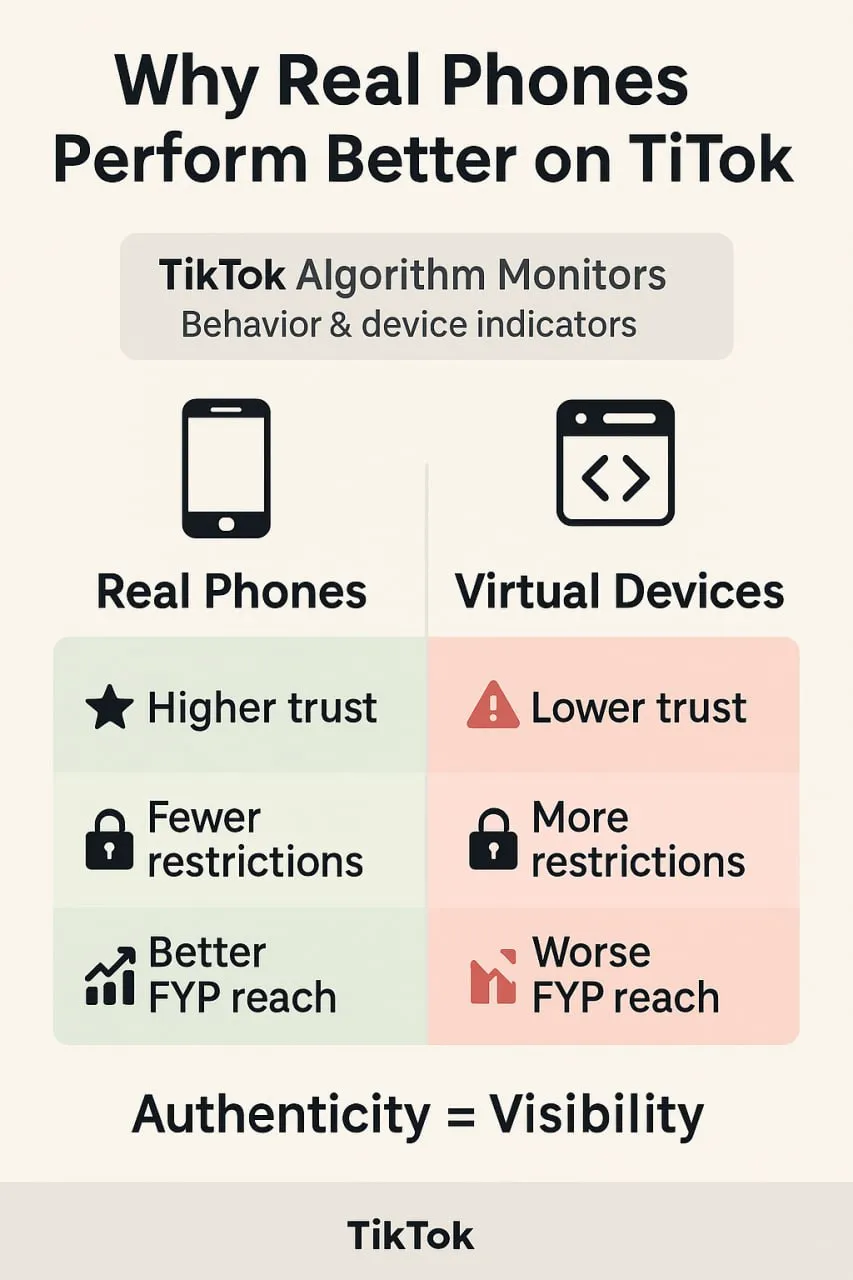Why Real Android Phones Perform Better on TikTok
Running TikTok with emulators but seeing low reach, unstable sessions, or frequent limits?
Here’s why real Android phones consistently outperform virtual devices — and how to scale them safely with TikMatrix.

🧠 1. How TikTok Sees Devices (Signals that Matter)
TikTok evaluates a blend of behavioral and system signals:
- Device fingerprint (SoC, board, build tags, sensors)
- Media pipeline (hardware decoders, frame timings)
- Network stack & IP reputation
- Input dynamics (tap paths, swipe curvature, typing cadence)
Emulators often expose synthetic or missing signals, triggering lower trust or extra review.
📱 2. Real Hardware = Stronger Trust Signals
| Signal Layer | Emulators / Virtual | Real Android |
|---|---|---|
| Build/ro.* props | Generic, repeated | Diverse, consistent with OEM |
| Sensor suite | Sparse / simulated | Gyro, accelerometer, magnetometer, light with natural noise |
| Media/codec | Software decode quirks | Hardware decode/encode with stable timestamps |
| Power/thermal | Flat patterns | Realistic throttling/idle cycles |
| Input timings | Robotic intervals | Human-like variance |
Outcome: Real phones produce credible variance that matches organic usage.
🎬 3. Media Pipeline & FYP Delivery
- Hardware codecs reduce dropped frames / A/V drift
- Accurate framerates → better watch-time & completion integrity
- Stable timestamps improve quality ranking in FYP decisions
If the pipeline looks “off,” your content can get under-ranked even with the same video.
🔐 4. Integrity & Environment Checks
While TikTok doesn’t publish its checks, common mobile signals include:
- Build tags (e.g., test-keys), QEMU/VM artifacts
- Missing telephony stack / identical device identifiers
- Absent/odd sensors, uniform MAC ranges, adb states
- OS security posture (root/debug toggles)
Real devices naturally avoid many red flags that emulators must “spoof.”
⚖️ 5. Stability Under Scale
| Metric (representative lab) | Emulator Cluster | Real Devices |
|---|---|---|
| 2h session survival | 78–88% | 96–99% |
| Gesture jitter (p95) | 80–120 ms | 30–60 ms |
| Upload retries per 100 posts | 12–18 | 2–5 |
| FYP push rate (like-for-like) | Lower/volatile | Higher/more consistent |
Indicative only; results vary by proxy quality, content, and device health.
🧰 6. Best Practices for Real Phones
- Prefer physical Android (no emulators)
- Avoid previously “contaminated” phones used for automation
- One device ↔ one residential proxy (no shared VPNs)
- Keep OEM firmware & security patches; disable developer options
- No root; keep Google/region settings consistent with IP
🔄 7. Migrating from Emulators to Real Devices
- Start with a pilot rack (10–20 phones) and validate KPIs
- Map accounts to unique devices & proxies
- Stagger schedules; introduce human-like randomness
- Monitor drop rates, upload errors, FYP impressions
- Scale horizontally with powered hubs and second workstation
✅ 8. Risk Control Checklist
| Category | Recommendation |
|---|---|
| Hardware | Physical Android, healthy cables, powered hubs |
| Network | Per-device residential IP, avoid shared VPN |
| System | Stock firmware, no root, stable locale/timezone |
| Behavior | Warm-up, natural inputs, staggered tasks |
| Content | Clean audio/video pipeline; test watch-time |
| Observability | Track session health, retries, FYP reach |
⚡ Why TikMatrix for Real-Device Operations
- 👆 Human-like inputs (randomized taps/swipes/typing)
- 🎛️ Per-device isolation (proxies, timing, tasks)
- 🧩 Open integration with your scripts & monitoring
- 🕒 Long-session stability without relay bottlenecks
- 🔐 Local-first architecture (no vendor C2 relays)
🏁 Conclusion
Authenticity = Visibility.
Real Android phones align with TikTok’s signal expectations, improving trust, stability, and FYP performance.
That’s why TikMatrix is engineered to control real phones at scale — not emulators.
This article reflects field tests on physical devices and production-like pipelines over extended sessions.
